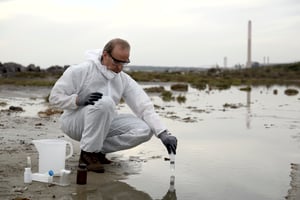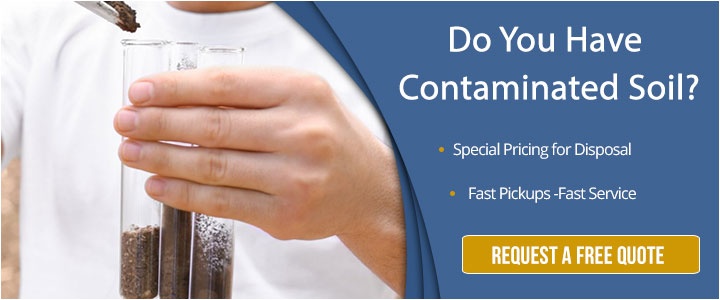As the “earth’s kidney,” soil plays a vital role in filtering and purifying water, regulating nutrient cycles and supporting the growth of diverse ecosystems.
So when soil becomes contaminated with toxic substances, a devastating domino effect can occur. Soil contamination can lead to the degradation of essential soil nutrients, which can then impact plant growth and, ultimately, the entire food chain.
When humans come into contact with contaminated soil, either through direct contact or by consuming plants and animals that have been exposed to the toxins, it can have severe implications for their health, from acute effects like skin irritation to chronic conditions like cancer and developmental disorders.
Exactly what and how much damage occurs often depends on the extent of the contamination and what toxic substances have penetrated the soil.
Common Soil Contaminants
There is a significant number of substances used in industry, agriculture, mining and other fields today that can contaminate soil. Common contaminated soil categories include: 
- Inorganics
- Semi-volatile organics
- Volatile organic compounds
- Fuels
Inorganic compounds typically lack carbon-hydrogen bonds and come from sources like facilities where smelting occurs, plating shops and other industrial activities with various manufacturing processes. Examples include:
- Lead
- Chromium
- Arsenic
- Mercury
- Other metals
- Leaded gasoline
- Lead-based paint
When soil becomes contaminated with inorganic compounds, a nutrient imbalance can occur. Heavy metals can bind soil particles or dissolve in soil water, interfering with the availability and uptake of nutrients by plants. This imbalance can lead to nutrient deficiencies or toxicities and can negatively impact plant growth and crop productivity.
Semi-volatile organics are a subgroup of VOCs that typically have a higher molecular weight and higher boiling point temperatures. Source materials like transformers, manufactured gas plants, burn pits and various agricultural processes slowly emit semi-volatile organics, which then divide until they settle as dust. Examples include:
- Polychlorinated biphenyls (PCBs)
- Polynuclear aromatic hydrocarbons (PAHs)
- Dioxins/furans
- Pesticides
When soil becomes contaminated with semi-volatile organics, they can remain for extended periods of time. Because they tend to have higher molecular weights than VOCs, they are less prone to rapid evaporation. This can result in long-term contamination of the soil, posing risks even after the initial source of contamination has been removed.
Volatile organic compounds, or commonly known as VOCs, are organic chemical compounds that evaporate easily at room temperature. Petroleum fuels, hydraulic fluids, paint thinners and dry cleaning agents are often responsible for VOCs. They are also commonly found at or produced by dry cleaners and at chemical and plastics manufacturing plants. Examples include:
- Industrial solvents like trichloroethylene
- Fuel oxygenates such as methyl tert-butyl ether (MTBE)
- Benzene
- By-products produced by chlorination in water treatment, like chloroform
When soil becomes contaminated with VOCs, its physical, chemical and biological properties can suffer. VOCs can also alter soil structure, reducing its porosity and impairing water infiltration and retention capabilities. VOCs can also affect microbial activity and nutrient cycling in the soil. Because VOCs can easily evaporate from soil into the air and can dissolve in water, there is a significant risk to both air quality and groundwater.
Fuels are often used to produce heat or power since they are designed to react with other substances to release energy. Leaking underground storage tanks and refineries can be responsible for fuels leaking into soil. Examples include:
- Gasoline
- Diesel
- Jet fuels
- Waste oils
When soil becomes contaminated with fuel, hydrocarbons can reduce soil porosity, disrupt soil structure and decrease water infiltration. This can result in poor soil fertility and reduced plant growth. Fuel spills also can infiltrate the soil and reach groundwater sources. Because hydrocarbons are insoluble in water, they tend to float on the water table and form a separate layer. This poses a risk to groundwater and can compromise drinking water supplies.
When soil becomes contaminated with any of the above toxins, it can have cascading effects on ecosystems. The toxic compounds can bioaccumulate in plants and then biomagnify as they move up the food chain, affecting herbivores, predators and even humans who consume contaminated plants or animals.
Direct exposure to these contaminants can also pose health risks to human health through skin contact, inhalation of dust or ingesting plants and animals that have accumulated these compounds. Health issues include respiratory problems, skin conditions, organ damage and in extreme cases, cancer or neurological disorders.
Remediation Strategies Address Contaminated Soil
Several professions and industries can either contribute to soil contamination or play a role in uncovering contaminated soil, from manufacturing companies to mining companies, agriculture, construction and demolition crews, and environmental agencies.
contaminated soil, from manufacturing companies to mining companies, agriculture, construction and demolition crews, and environmental agencies.
When these workers discover contaminated soil, it’s critical to take action to prevent the further spread of the contamination. The most common soil clean-up options include:
- Containment: Heavy-duty liners are placed under and around any contaminated solid to prevent the migration of contaminants into soil or groundwater. A landfill cap then serves as a barrier layer that prevents toxic effects on nearby areas.
- Bioremediation: This process uses organic materials to initiate biological processes in the soil that eventually will remove contaminants. Microorganisms such as bacteria and fungi are used in this process because they use the contaminant as a food source.
- Chemical oxidation: A compound is injected into the area of soil contamination to destroy the contaminants. This solution can be used when soil contamination occurs at deep levels below a structure.
- Soil washing: A solution consisting of cleaning fluid and water passes through a polluted soil sample in order to physically separate soil from its contaminants. Contaminants are more likely to bind to fine-grained soil and silt, and soil washing effectively removes these fine-grained pieces from the larger soil sample.
- Thermal treatment: This method moves contaminants or destroys them using heat. When contaminants move through the soil toward another location, crews collect them and pipe them to the ground surface. Also known as “in situ,” the heat is applied directly to the original area of contamination.
Proper Transportation Critical To The Disposal Process
To transport contaminated soil to a treatment facility that will use one of the methods outlined above, it’s critical to ensure your soil pollution disposal plan includes safe transportation from your sites.
Hazardous waste disposal companies can help by removing the contaminated soil and transporting it to the designed facility for treatment and final disposal. The best disposal companies will also offer hazardous waste determination through sampling and profiling so you can determine which toxic substances have infiltrated the soil.
The best soil contamination disposal services will also help you complete regulatory paperwork and provide you with proof that your contaminated soil has been properly disposed of to keep for your records.
Because you’re responsible for the contaminated soil your team has uncovered (or caused, in some cases), it’s important to only work with certified companies that are registered with the DTSC. Avoid hazardous waste brokers that will act as unqualified middlemen and drive up costs, and check to ensure a disposal company has experience in transporting soil that has been contaminated with the same hazardous substances you have uncovered.
One final way you can determine whether a disposal company is at the top of its industry is if it offers a hazardous waste walk-through program. Consultative in nature, walk-through programs can help you identify potentially contaminated soil through sampling and testing, as well as identify any potential problems that you may not recognize in your waste management plans in order to protect your business in the future.


Comment